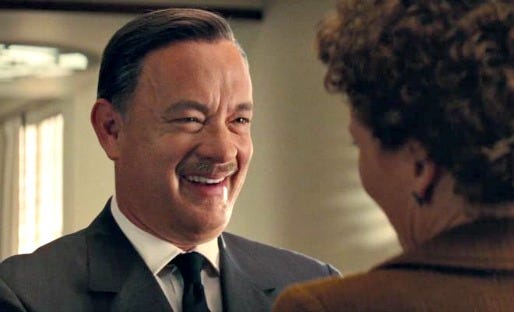Saving Mr. Banks

Hollywood loves to tell stories about itself, and here’s a movie from Walt Disney Pictures about the making of one of its own iconic films, and starring Walt himself. Or rather, co-starring Tom Hanks as Walt Disney, a supporting role for the main character of author P.L. Travers, played by Emma Thompson.
The tale is quite simple: the irascible, guarded Mrs. Travers – don’t you dare call her Miss – doesn’t want to sell her novel “Mary Poppins” to Disney and see it turned into a piece of puffy fantasy. But she needs the money, and agrees to come out to California to collaborate with the film’s production team, while Old Walt works his twinkly charm to convince her to sign over the book rights.
The movie is essentially one long dance between Travers and Disney, with the two struggling mightily to understand a person so extravagantly different from themselves. Of course, we know how it all turned out.
(Or, at least we think we do. The film ends with the pair more or less making their peace over their very different conceptions for “Mary Poppins,” but in fact she so reviled what Disney did with her work that she forbade any further adaptations of her books.)
I really wanted to like this movie, but it held so very few surprises for me. We know early on from the flashbacks to Travers’ Australian childhood that she adored her sweet, alcoholic wastrel father (Colin Farrell) and used him as the basis for the father figure, Mr. Banks, in “Mary Poppins.” So it’s all a matter of Disney learning enough about her to puzzle out the truth.
The scene where he finally confronts her about her fears is splendidly acted by Hanks and Thompson, but flat as dry toast. It’s never a good thing when the audience is three steps ahead of the characters.
The early section is mostly about Travers playing the fish-out-of-water role, peevishly negotiating the Hollywood scene. She’s disruptive and contemptuous, treating everyone she meets quite shabbily, especially Disney’s underlings. She even dismisses the songs written for the film by the legendary Sherman Brothers (B.J. Novak and Jason Schwartzman), and regards some animated critters as vile interlopers.
Bradley Whitford turns up as screenwriter Don DaGradi, Kathy Baker is a tough studio exec and Rachel Griffiths plays Travers’ aunt. Paul Giamatti brightens things up as her appointed chauffeur, an obstinately cheerful man who serves absolutely no purpose in the story, but we just like having him around.
Since we’re discussing a film about the creative process, let me tell you a little bit about mine. I prefer to see one movie at a time, write the review within the next 24 hours, more or less be absorbed in that experience, and move on to the next. The crush of late-year screenings made that impossible, and quite frankly, I’m having trouble recalling “Saving Mr. Banks” very well. It’s only been a few days since I’ve seen it, but mentally it’s already slipping through my fingers like sand.
The best movies, and sometimes even the worst, stick with you because they make a strong impression that lingers. There are films I’ve seen only a single time many years ago that I can evoke with great clarity, both the movie itself and how I reacted to it at the time.
I’m afraid “Saving Mr. Banks” is already floating away like Poppins herself, she to her next nanny job and me the next movie review. I just wish there had been a spoonful of magic while we journeyed together.
3.5 Yaps



